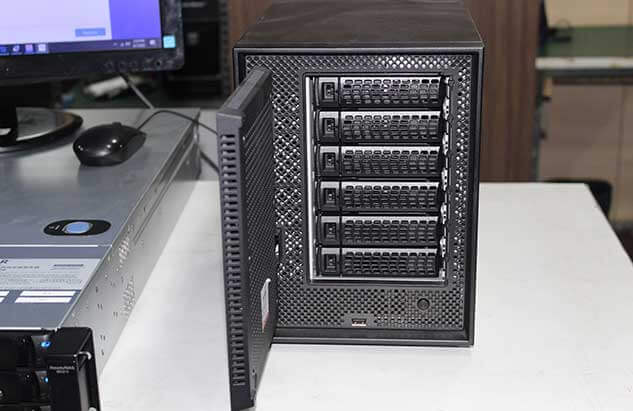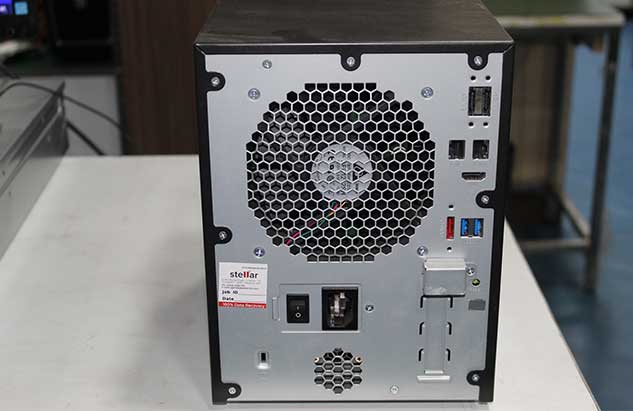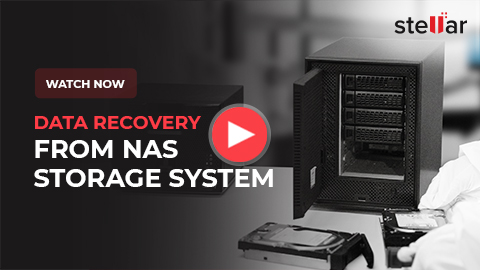Chapter 2 of 5 | Published On
While a NAS might sound like the best of all worlds (speed, space, security), it’s limited in its scope, particularly for applications with near zero tolerance for latency. That’s where SAN emerges as an advanced alternative to NAS.
In the previous chapter, we learned:
- What is NAS?
- Where is it used?
- What are the common RAID configurations for NAS?
In this chapter, we'll understand:
The limitations of NAS
- What is SAN?
- Which is better: NAS or SAN?
- The differences between NAS and SAN
- How does it eliminate some of the limitations of NAS?
- Why does NAS prove to be limiting for some organizations, and in some applications where latency tolerance is near-zero.
What Are The Limitations Of NAS?
We know that organisations use NAS as an inexpensive system of making data available for multiple devices at the same time, over a network.
This is what a NAS box looks like:

Front

Back
Limitation #1: Data From NAS Seems To Load Slowly/Latency In Data Transmission
NAS is limited in its performance and scalability; we'll understand how.
Before that, let's understand how data is made accessible to multiple devices by a NAS box. This is done by an Ethernet connection (between the NAS and the router). Ethernet-based data transfer works as follows.
- The source data is divided into a number of segments (called packets).
- These packets are then transmitted over the network to their destination.
- These packets could be sent out of order (because of network congestion).
- These packets must be rearranged in the right sequence at the destination.
- The file isn't available at the destination device until the packets have arrived and been arranged in the right sequence.
The resulting latency—in most cases—isn't noticeable to a user. However, when the files are large (such as video files), even the latency of a few milliseconds is noticeable and disrupts the user experience.
Limitation #2: Adding More Users Means The Performance Goes Down/Scalability Isn’t Seamless
As more devices are connected to the network, the server's resources are divided, which reduces the speed of data transmission. In such case, your options are to:
- Replace the NAS processor with a more powerful version,
- Add more RAM, and
- Use the fastest network connections.
This is doable, but not easy. You might create more problems unless you engage a certified IT professional to assist with the upgrade, which will be expensive.
For most organisations that find NAS boxes limiting to their growing
data needs, the logical upgrade is SAN.
What Is SAN, And How Is It A Solution To The Limitations of NAS?
SAN stands for Storage Area Networks.
The Biggest SAN Advantage: High-Speed Data Transfer Via Fibre Channel
The original (and most preferred) data transfer protocol in a SAN setup is Fibre Channel. Some SAN setups may also use a private Ethernet network between the server
and clients to isolate the file request traffic out of the Fibre Channel network. This is to further improve the performance of the SAN.
In a SAN, the server, clients, and storage are on a Fibre Channel network. This means that SAN volumes appear and behave like directly connected hard drives.
Because there's no packetization during data transfer in SAN, the data access speeds are higher, irrespective of the high number of users.
Which Is Better: NAS or SAN?
There is no straightforward answer to this question.
Both NAS and SAN try to answer a crucial storage question: how do we make storage available to multiple users while keeping it secure.
Both systems approach the problem in different ways, and in doing so, offer certain advantages and disadvantages.
NAS and SAN: Advantages And Disadvantages
Simplicity versus Performance
NAS is a much simpler, quicker, and more affordable solution than SAN for most small and mid-sized businesses. However, SAN is the right choice for organisations where there's no tolerance for latency.
Relatively, NAS shows higher latency in data transmission because of the packetization of data. SAN is known for higher data-transmission speeds and is preferred in applications such as high-speed transaction databases and ecommerce
websites.
Which is better? Depends on what you need more. NAS is more convenient, while SAN is better for low latency.
Fault Tolerance
In NAS, there’s a certain level of fault-tolerance in almost every RAID configuration. The typical RAID 10 configuration of a NAS box allows
1 drive failure/pair. There are other RAID configurations too, each with a different level of fault tolerance. This isn’t comparable to the fault-tolerance features of a SAN, though.
In a SAN, high availability is built into the system at all levels. The RAID in a SAN can withstand single/multiple disk failures. There is multipath I/O to ensure uninterrupted access to storage even when there’s a link failure.
Read Case Study
Which is better? SAN.
Scalability
While NAS boxes can be scaled up to support petabytes of storage using clusters and scale-out nodes, this isn't straightforward. In SANs network architecture allows admins to scale up storage and performance.
Which is better? SAN
Affordability
The total cost of ownership of a NAS is predictable, and a NAS box is inexpensive to maintain. SANs are complicated, involve more hardware components, and demand investment in their maintenance. This pushes the total cost of ownership of SAN
to many times their purchase cost. However, for several large organisations, given the mission-critical nature of their applications, this investment is totally justified.
Which is better? NAS will always be cheaper than SAN.
Maintenance
Managing a single NAS box is easy. It plugs into a local area network, and that's it. However, when you install another NAS box whose management console is different from the first one, then the admin challenges mount. In the case of
SAN, management is more complex, and more administrative efforts are required.
Which is better? You’ll need more admin and maintenance resources for SAN.
NAS versus SAN: Key Differences
| NAS | SAN |
|---|---|
|
|
|
|
|
|
|
|
|
|
|
|
|
|
|
|
More About SAN: The Technical Details
Here are the key points about SAN.
SAN Hardware Components
The hardware components of SAN are:
- Storage devices like RAID arrays
- Hubs or switches
- Fibre Channel host bus adapters
- Cables (copper or optical)
SAN Software Components
The software components of SAN are:
- Device drivers for the host bus adapters
- Management software
- Special function host software
SAN Protocols
The hardware components are connected using different protocols such as
- Fibre Channel
- Fibre Channel over Ethernet (FCoE)
- Internet Small Computing System Interface (iSCSI)
- InfiniBand
NAS versus SAN: An Unfair Comparison?
NAS and SAN aim to satisfy two different types of customers. They’re more complementary than contrasting. Many organizations use both NAS and SAN. So, which one among NAS and SAN should you choose, depends wholly on what you want to use them for.
If you are looking for NAS data recovery, contact us today.





